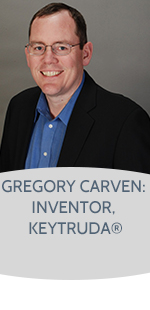 One Drug That Might Hold the “Key” to Multiple Cancers
One Drug That Might Hold the “Key” to Multiple Cancers
The 2016 IPO Education Foundation’s Inventor of the Year Award will honor six life-saving cancer immunotherapies at its Annual Foundation Awards Dinner in Washington, D.C. on 6 December 2016. One of the winners is Merck & Co. Inc.’s KEYTRUDA, which works by blocking the programmed cell death protein 1 (PD-1) pathway expressed on T Cells (a type of white blood cell). KEYTRUDA is currently approved in the United States for the treatment of advanced melanoma, metastatic non-small cell lung cancer (NSCLC) that tests positive for PD-L1, and advanced head and neck squamous cell cancer (HNSCC) following platinum-containing chemotherapy.
Representing the team that invented KEYTRUDA is Gregory Carven, who now works for biotechnology company, Scholar Rock. Dr. Carven will accept the award along with fellow inventors Hans van Eenennaam and John Dulos, both of whom now work for Aduro Biotech Europe. He spoke with Innovator Insights™ about how KEYTRUDA and other cancer immunotherapies represent a “paradigm shift in the treatment of cancer,” how post-graduate patent programs could be beneficial for scientific research, and what the future holds for cancer treatment.
What was your previous position with Merck, and what was your role in developing KEYTRUDA?
I was originally trained as a chemist, but over time I moved away from chemistry and into biologics drug discovery. I’ve learned a lot of immunology along the way, which led to my interest in antibody therapeutics. I joined Organon in 2005 at a newly created research site in Cambridge, Massachusetts, which was focused on the discovery of antibodies as therapeutics. It was at Organon that KEYTRUDA was first discovered, by a small team of scientists split between the Cambridge site and Oss, Netherlands. Organon was acquired by Schering-Plough in 2007, which was itself acquired by Merck two years later.
What does KEYTRUDA do, and how?
It’s actually surprising that I have never had any formal training in intellectual property or patents. Being an inventor on multiple patents and applications has led to a lot of learning on the fly.
Unlike chemotherapy, KEYTRUDA does not act directly on tumors. KEYTRUDA acts on a particular type of cell in a patient’s immune system called a T-cell. KEYTRUDA blocks the activity of a protein, PD-1, which normally acts as a type of “off switch” that helps keep T-cells from attacking other cells in the body. This blockade activates the T-cells, releasing the brakes on the immune system, thus allowing it to detect cancer cells as foreign and overcome one of cancer’s main defenses against an immune system attack.
How is it a step forward for cancer treatment/an improvement over previous approaches?
By targeting the patient’s immune system rather than the tumor directly, checkpoint inhibitors such as KEYTRUDA have demonstrated efficacy in a wide-ranging set of tumor types, from skin and lung cancer, for which KEYTRUDA is approved, to others such as bladder and colorectal cancer, which are still in testing. Additionally, the side-effect profile for checkpoint inhibitors seems to be considerably more tolerable than traditional therapies.
What role have patents played in your work—have you had to learn a lot about them?
Patents play an important role in my work as a drug discovery scientist. I believe that it is important to protect creative and innovative ideas, particularly in a setting where the path to bring a new medicine to patients is long and expensive.
Did you receive training on patents in school or during your career at any point?
It’s actually surprising that I have never had any formal training in intellectual property or patents. I have been involved in the patent application process multiple times dating back to graduate school where I was involved in the discovery of a diagnostic tool for monitoring immune responses. Being an inventor on multiple patents and applications has led to a lot of learning on the fly as each application moves along the different phases before being issued.
What does KEYTRUDA represent in the larger effort to cure cancer, and what are your hopes for the next decade or so of cancer treatment?
The key to cure cancer in more settings lies in combining immunotherapy with other approaches.
To me, immunotherapies represent a paradigm shift in the treatment of cancer. Instead of focusing only on therapies which work directly on tumor cells, such as chemotherapy or even targeted therapy, the field has just begun to take advantage of the body’s own anti-cancer mechanisms. But checkpoint inhibitors like KEYTRUDA do not work in all cases or all cancer types, as some cancers are able to evade the immune system despite a checkpoint blockade. Thus over the next decade, I believe that the key to cure cancer in more settings lies in combining immunotherapy with other approaches. Currently, hundreds of human clinical trials are ongoing which are testing KEYTRUDA in combination with other drugs ranging from traditional chemotherapy, to targeted/personalized therapies, to vaccines and oncolytic viruses. It is in these combinations that I expect we will see the true potential of immunotherapy.
What does receiving the award mean to you, and what would like to say about the other winners, if anything?
I am truly honored to receive this award. To the other winners, I would say congratulations and that I appreciate the hard work that went into bringing their products forward. I’m glad that patients are able to benefit from multiple different immunotherapies and I’m excited to see how these drugs become used in standard practice.
[ssba-buttons]



